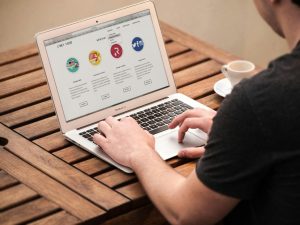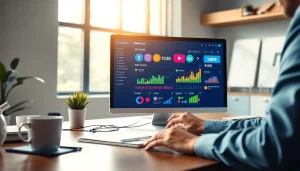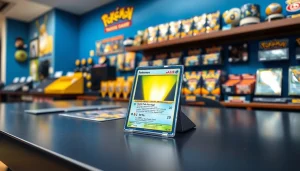Understanding the B2B Buyer: Essential Insights for Successful Marketing
1. Defining the B2B Buyer
Understanding the concept of the B2b buyer is critical as businesses tailor their strategies to meet the unique needs of this group. In a professional setting, B2B buyers are not just decision-makers; they embody specific characteristics that influence their purchasing behavior. A nuanced comprehension of who they are and what drives their intent is vital for any B2B strategy’s success.
1.1 Characteristics of B2B Buyers
B2B buyers typically show a range of defining characteristics that differentiate them from B2C (business-to-consumer) customers. Primarily, they often represent businesses rather than individual consumers, impacting their purchasing process significantly. Some prominent traits include:
- Analytical Approach: B2B buyers rely heavily on data and metrics, making decisions based on quantifiable results rather than emotional triggers, which are more common in B2C transactions.
- Complex Decision-Making: The buying process usually involves multiple stakeholders, requiring consensus among various departments such as finance, operations, and IT.
- Longer Sales Cycles: Due to the level of scrutiny and evaluation required before making a purchase, the sales cycle can be significantly longer compared to B2C transactions.
- Focus on Value and ROI: The emphasis is on value, reliability, and return on investment (ROI) because B2B purchases directly impact the organization’s bottom line.
1.2 The Importance of Understanding B2B Buyer Intent
Understanding buyer intent is crucial for tailoring marketing strategies. B2B buyer intent refers to the motivations behind their purchasing behavior. Businesses can segment these intentions into three main categories:
- Researching: Buyers look for information that can help them understand their situation or solve a problem.
- Comparing: At this stage, buyers actively seek options, features, prices, and benefits, appearing at the evaluation stage of the buying process.
- Purchasing: This occurs when the buyers are ready to commit, generally after thorough analysis and comparison of alternatives.
Recognizing these intents allows marketers to create content and touchpoints that cater specifically to each phase of the buying journey, thereby increasing engagement and conversion rates.
1.3 Key Differences Between B2B and B2C Buyers
While both B2B and B2C buyers aim to fulfill specific needs, they differ significantly in their purchasing behaviors:
| B2B Buyers | B2C Buyers |
|---|---|
| Group decision-making involving multiple stakeholders | Individual decision-making |
| Longer sales cycles, often spanning several months | Shorter, impulse-driven purchasing |
| Focus on relationships and long-term partnerships | Focus on one-time transactions or brand loyalty |
| Emphasis on product features and ROI | Emphasis on emotional triggers and brand image |
Clear acknowledgment of these distinctions aids marketers in pivoting their approaches accordingly, thereby enhancing the overall effectiveness of their strategies.
2. The B2B Buyer Journey Explained
The B2B buyer journey outlines the steps buyers take from identifying a need to making a purchase. Understanding this journey enables marketers to create relevant content that resonates throughout the process.
2.1 Stages of the B2B Buyer Journey
The B2B buyer journey can generally be broken down into the following stages:
- Aware: The buyer identifies a problem or opportunity that needs addressing.
- Consider: At this point, the buyer evaluates potential solutions, diving deeper into research.
- Decide: The final stage involves selecting a particular product or service after comparing options.
Each of these stages requires tailored content to guide the potential buyer effectively towards the final decision. Understanding these stages can also aid businesses in identifying where to apply additional resources or focus.
2.2 Content Strategies for Each Stage
Creating tailored content for each stage of the buyer journey ensures that prospects receive the information they need when they need it:
- Aware Stage: Blog posts, articles, and infographics that introduce common problems faced by businesses.
- Consider Stage: Case studies, webinars, and comparison guides that outline the advantages of different solutions.
- Decide Stage: Product demos, testimonials, and white papers that provide evidence to bolster the final decision.
This strategic alignment of content to the buyer’s journey improves engagement and supports higher conversion rates.
2.3 Common Challenges Faced by B2B Buyers
B2B buyers face several challenges throughout their journey. Recognizing these challenges enables businesses to preemptively address concerns and enhance user experiences:
- Information Overload: The abundance of information available online can be overwhelming, leading to analysis paralysis.
- Trust Issues: Building trust is essential, especially when significant financial investments are involved.
- Complexity in Decision-Making: With multiple stakeholders involved, reaching a consensus can be difficult.
By being aware of these challenges, businesses can create strategic plans that address these issues, helping to smooth the journey for prospective buyers.
3. Building Effective Buyer Personas for B2B
Creating detailed buyer personas is key to effective targeting in B2B marketing. These personas represent semi-fictional characters based on real data and insights about your B2B buyer.
3.1 Identifying Target B2B Buyer Segments
Identifying the right segments ensures that marketing efforts focus on the most relevant audiences. These segments can be defined by:
- Industry: Different industries have unique needs and challenges. Understanding these will enable targeted messaging.
- Company Size: Larger enterprises often have complex needs compared to small and medium-sized enterprises (SMEs).
- Geographic Location: Business practices and preferences can vary widely across different geographies.
Abstracting these segments into clear personas will guide marketing efforts, ensuring they resonate deeply with each targeted audience.
3.2 Tools and Techniques for Persona Development
Several techniques and tools can assist in developing effective buyer personas:
- Surveys and Interviews: Gathering firsthand feedback can provide essential insights into the buyer’s motivations and behaviors.
- Data Analysis: Leverage analytics tools to analyze website behavior and understand how potential buyers interact with content.
- Social Listening: Monitor conversations on social media to gain insights into industry trends and customer pain points.
By combining qualitative insights with quantitative data, businesses can construct well-rounded personas that accurately reflect their target audience.
3.3 Using Persona Insights to Drive Strategy
Using the insights gleaned from buyer personas can enhance marketing effectiveness significantly. Businesses should focus on:
- Content Creation: Tailoring content to suit the interests, needs, and challenges of each persona.
- Channel Selection: Choosing the right platforms where target personas are more likely to engage.
- Personalization: Implementing personalization strategies to provide bespoke experiences based on persona data.
When personas guide strategy, marketing becomes more focused, relevant, and measurable, enhancing overall effectiveness.
4. Enhancing Engagement with B2B Buyers
Engagement plays a pivotal role in the B2B landscape, influencing how relationships are cultivated and deals are closed.
4.1 Effective Communication Tactics for B2B
To communicate effectively with B2B buyers, consider the following tactics:
- Clarity and Conciseness: Ensure that communication is straightforward and free from jargon, which can confuse more than clarify.
- Active Listening: Engaging deeply with buyers’ needs will foster trust and enable better alignment of solutions.
- Consistent Follow-Up: Regular follow-ups demonstrate that you value the relationship and are committed to meeting their needs.
These tactics not only enhance communication but also build lasting relationships with buyers, ultimately facilitating smoother transactions.
4.2 Leveraging Digital Tools for B2B Engagement
Modern digital tools can significantly enhance engagement strategies, including:
- CRM Systems: Utilizing Customer Relationship Management systems to manage interactions and nurture leads.
- Marketing Automation: Implement automated campaigns that can deliver relevant content based on buyer behavior.
- Social Media Platforms: Use social media to engage, share insights, and connect with B2B buyers in a more informal setting.
Incorporating these tools can help streamline efforts and make engagement with B2B buyers more effective overall.
4.3 Measuring Engagement Success with B2B Buyers
Measuring engagement success involves analyzing specific metrics to determine how well the strategies are performing:
- Conversion Rates: Evaluate how many leads convert into paying customers as an indicator of effective engagement.
- Customer Feedback: Continuously solicit feedback to gauge satisfaction and areas for improvement.
- Growth in Engagement Metrics: Monitor metrics such as open rates for emails and social media interactions to assess overall engagement levels.
Putting measurable evaluations in place allows businesses to iterate and enhance engagement strategies continually, ensuring they remain responsive to the needs of B2B buyers.
5. Future Trends in B2B Buyer Behavior
Looking ahead, understanding the evolving landscape of B2B buyer behavior can help businesses adapt their strategies effectively.
5.1 Impact of Technology on B2B Buying
The integration of advanced technologies will continue to redefine the B2B buying experience. Upcoming trends include:
- AI and Machine Learning: Using AI to personalize communication and streamline the buyer journey.
- Data-Driven Decision Making: Enhanced analytics will provide deeper buyer insights, allowing for tailored marketing strategies.
- Increased Use of eCommerce: More B2B purchases will transition to online platforms, necessitating a robust digital sales presence.
Staying abreast of these technological advancements will equip businesses to meet future buyer expectations more proactively.
5.2 Predicting Changes in B2B Buyer Preferences
As the market evolves, so do buyer preferences. Key shifts to anticipate include:
- Desire for Autonomy: Buyers increasingly prefer to conduct research independently before engaging with sales representatives.
- Value-Driven Purchases: As economic conditions fluctuate, buyers will prioritize cost-efficiency and added value.
- Sustainability Concerns: More B2B buyers will consider environmental impact when selecting suppliers.
Keeping ahead of these trends will be crucial for creating effective marketing strategies that resonate with prospective buyers.
5.3 Adapting Strategies for Future B2B Buyers
To navigate the changing dynamics of B2B buyer behavior, businesses should focus on several adaptive strategies:
- Emphasize Digital Transformation: Invest in comprehensive digital solutions that enhance online shopping experiences.
- Offer Flexibility: Allow buyers to choose how they engage with sales teams, whether through chatbots, self-service portals, or traditional outreach.
- Build a Community: Foster an interactive community around your brand to encourage loyalty and collaboration.
By embracing a forward-thinking approach, businesses can succeed in meeting the evolving demands of B2B buyers.














Post Comment